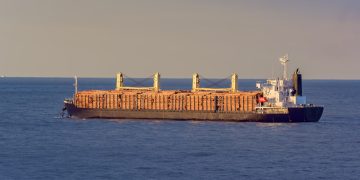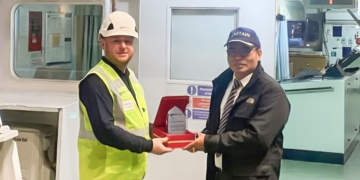NTSB issued an investigation report on the contact of the bulk carrier Atlantic Huron with the Soo Locks West Center Pier, Michigan, in July 2020. The investigation identified not following the manufacturer’s requirements on the vessel’s controllable pitch propeller system, as a key cause of the accident.
The incident
On July 5, 2020, about 0250 local time, the self-unloading bulk carrier Atlantic Huron was transiting the Upper St. Marys River, west of the Soo Locks, in Sault Sainte Marie, Michigan, with a crew of 25 onboard.
While on approach to the locks and attempting to slow, there was a propulsion problem involving the vessel’s controllable pitch propeller (CPP) system. The vessel subsequently contacted the west center pier at 6.8 knots.
Before reaching the lock gate, the vessel’s motion was halted, and the crew moored the vessel to the pier. There were neither injuries nor pollution. Damages to the vessel ($1,633,000) and pier ($573,000) were estimated at $2.2 million.
Probable causes
The National Transportation Safety Board determines that the probable cause of the contact between the Atlantic Huron and the west center pier at Soo Locks was not following the manufacturer’s requirement to use thread-locking fluid during installation of the feedback ring locking pin set screw on the vessel’s controllable pitch propeller system, which led to the failure of the controllable pitch propeller’s oil distribution box.
The manner in which the OD box failed, giving the captain an erroneous propeller pitch indication, combined with the EOW not being able to immediately explain why the vessel was speeding up, delayed the captain’s decision to secure the main engine.
The captain could have stopped the main engine to slow the vessel’s speed once he noticed the erratic operating pitch indicator accompanied by an increase in the vessel’s speed, and before deploying the anchors.
If the vessel’s main engine had been stopped when the failure to the OD box occurred or shortly after, the vessel’s speed would not have increased from 3.8 knots to 7.1 knots.
[smlsubform prepend=”GET THE SAFETY4SEA IN YOUR INBOX!” showname=false emailtxt=”” emailholder=”Enter your email address” showsubmit=true submittxt=”Submit” jsthanks=false thankyou=”Thank you for subscribing to our mailing list”]
It is also likely that if the vessel’s anchors were deployed at that time, given the approximate 0.5-mile distance from the end of the pier, the vessel would have been able to stop before contacting the pier.
However, given the relatively short period in which the accident unfolded and the limited time that remained before contact, after contacting the EOW, the captain focused on reaching the chief engineer to diagnose the problem.
Lessons learned
-Loss of Propulsion Control Procedures
Loss of propulsion control in a critical phase of operation demands crewmembers act quickly to mitigate potential accidents. Part of a safety management system should address potential emergency shipboard situations, including loss of propulsion, collision, and contact, and establish ways to respond to them.
Due to their unique blade control, vessels with controllable pitch propellers should have specific procedures for loss of engine and loss of pitch control. These emergency procedures should be well understood and practiced by crewmembers both on the bridge and in the engine room,
…NTSB advised.

































































